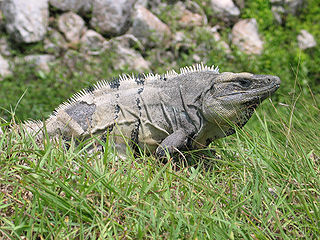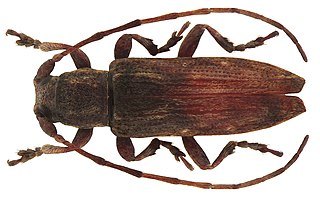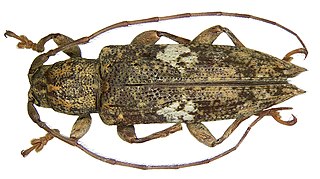
Ctenosaura is a lizard genus commonly known as spinytail iguanas or Ctenosaurs. The genus is part of the large lizard family, Iguanidae and is native to Mexico and Central America. The name is derived from two Greek words: ctenos (κτενός), meaning "comb", and saura (σαύρα), meaning "lizard".

The long-billed pipit or brown rock pipit is a passerine bird which has a wide distribution. A number of subspecies have been created for the populations in Africa, through the Arabian peninsula and South Asia. The systematics of this complex is yet to be clarified. Most birds are residents or short distance migrants.

Ctenosaura similis, commonly known as the black spiny-tailed iguana, black iguana, or black ctenosaur, is a lizard native to Mexico and Central America that has been introduced to the United States in the state of Florida. It is the largest species in the genus Ctenosaura and has been recorded as the fastest-running species of lizard.
Callinectes similis, sometimes called the lesser blue crab or dwarf crab, is a West Atlantic species of blue crab. It was described by Austin B. Williams in 1966.
Similodonta is an extinct genus of early bivalve in the extinct family Praenuculidae. The genus is one of eleven genera in the subfamily Praenuculinae. Similodonta is known from Middle Ordovician through Middle Silurian fossils found in Europe and North America. The genus currently contains eight accepted species, Similodonta ceryx, Similodonta collina, Similodonta djupvikensis, Similodonta magna, Similodonta recurva, Similodonta spjeldnaesi, Similodonta wahli and the type species Similodonta similis.

Sybra is a genus of beetles in the family Cerambycidae, containing the following species:

Sybra albomaculata is a species of beetle in the family Cerambycidae. It was described by Breuning in 1939. It contains two subspecies, Sybra albomaculata albomaculata and Sybra albomaculata formosana.

Sybra fuscoapicalis is a species of beetle in the family Cerambycidae. It was described by Breuning in 1939.
Sybra fuscotriangularis is a species of beetle in the family Cerambycidae. It was described by Breuning in 1939.
Sybra iconica is a species of beetle in the family Cerambycidae. It was described by Pascoe in 1865. It contains two subspecies, Sybra iconica clarevitticollis and Sybra iconica iconica.

Sybra umbratica is a species of beetle in the family Cerambycidae. It was described by Pascoe in 1865.
Sybra uenoi is a species of beetle in the family Cerambycidae. It was described by Hayashi in 1956. It is known from Japan.
Sybra bioculata is a species of beetle in the family Cerambycidae. It was described by Pic in 1925. It contains four subspecies: Sybra bioculata bioculata, Sybra bioculata quadrinotata, Sybra bioculata sikkimana, and Sybra bioculata tigrina.

Sybra mediomaculata is a species of beetle in the family Cerambycidae. It was described by Heller in 1924.
Sybra mimogeminata is a species of beetle in the family Cerambycidae. It was described by Breuning and Ohbayashi in 1964. It contains two subspecies, Sybra mimogeminata carinatipennis and Sybra mimogeminata mimogeminata.

Sybra ordinata is a species of beetle in the family Cerambycidae. It was described by Bates in 1873.
Sybra pascoei is a species of beetle in the family Cerambycidae. It was described by Lameere in 1893.
Sybra subfasciata is a species of beetle in the family Cerambycidae. It was described by Bates in 1884.

The Simili Tour was the eighth concert tour by Italian recording artist, Laura Pausini. Launched in the spring of 2016, the tour promoted her twelfth studio album Simili (2015). Over the course of five months, the tour visited Europe and the Americas.

Simili is an Italian-language studio album released by Laura Pausini on November 6, 2015, this is her twelfth studio album. Pausini also made a Spanish version of the album Similares, released on November 13, 2015. The first single was released on September 25, 2015 in two versions; in Italian "Lato Destro del Cuore", and the Spanish version "Lado Derecho del Corazón". The Spanish-language version of the album received a nomination for a Grammy Award for Best Latin Pop Album.












